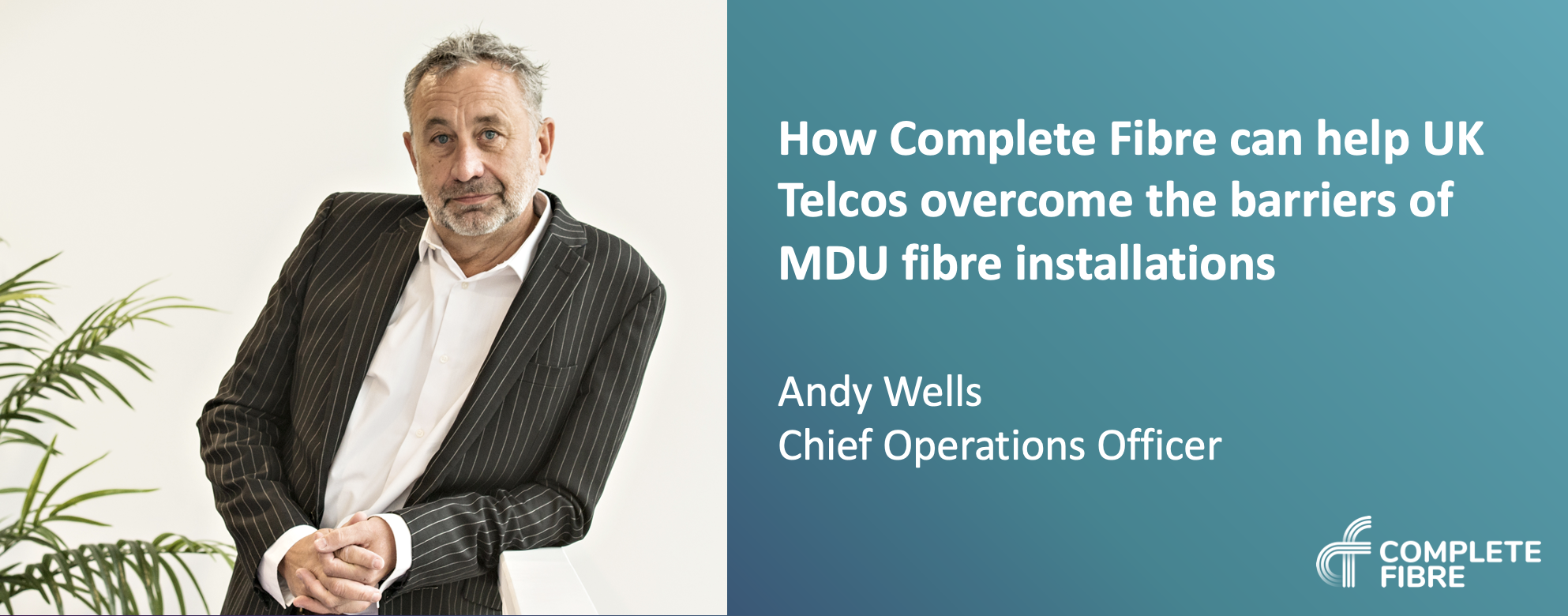Telecoms.com periodically invites expert third parties to share their views on the industry’s most pressing issues. In this piece Andy Wells, Founder and COO of Complete Fibre, explores best practice when it comes to installing fibre in multi dwelling units. Read more about the article below or at https://shorturl.at/dgqZ2
Project Gigabit, the UK government’s £5 billion plan to connect hard-to-reach properties to fibre optic broadband, is evidence of the value they place on digital inclusion. Access to high-speed internet means the ability to work remotely, work efficiently, communicate better and prevent children from being locked out of education.
Multi Dwelling Units (MDUs [blocks of flats]) present a significant challenge to Project Gigabit’s success and, more importantly, to digital inclusivity. Some 800,000 premises across London’s various boroughs do not have access to gigabit solutions, and over 60,000 having access via outdated, slow copper ADSL broadband (here).
These MDUs present a significant challenge for telcos, who have invested heavily in upgrading the nation’s fibre infrastructure and are seeking to connect as many residents to high-speed internet as possible, as rising interest rates, higher utility bills and an ongoing cost-of-living crisis have made life more difficult for consumers and telcos alike.
However, the obstacles to connecting MDUs to fibre optic networks are not just financial; there are issues of safety, logistics, regulation, construction risk, and communication that must not be overlooked. Internet service providers (ISPs) are all too aware of these challenges.
Landlords hold the key, literally – without them, access at scale is nearly impossible, but their tendency not to respond has left many telcos frustrated. However, landlords have many material issues beyond fibre rollout: damp, mould, fire safety, occupancy, EPC ratings, and so forth. Just staying compliant is a huge task, but adding repeated requests from multiple telcos makes their lack of response more understandable – especially given the many considerations they have regarding resident safety and welfare.
While it was hoped the Telecommunications Infrastructure (Leasehold Property) Act (TILPA) would help overcome the communications divide between telcos and landlords or housing associations, progress in the fibre rollout to MDUs remains challenging. For the benefit of both telcos and the residents and landlords of MDUs, a sustainable solution is required.
The importance of a standards-focused approach to fibre installation
In the aftermath of Grenfell, fire safety is, as it always should have been, the number one priority for building works; a renewed, stringent and comprehensive standards-focused approach to fibre installation in blocks of flats is needed. Fibre installation requires significant intervention to the MDU’s infrastructure, and repeated installations by varied actors greatly increase the risk of fire safety protocols being compromised.
Digital connectivity and inclusion are understandably a priority to both ISPs and the government, but the race to connect urban high-rises should not compromise recent progress towards improved safety compliance – nothing should supersede the significance of safeguarding lives and preventing avoidable tragedies.
For landlords, the most useful solution to ensuring safety protocols are met and audits are reliable would be creating smart buildings, employ digital twin technology that creates a visible record of each installation visit and adds to the MDU’s permanent records, or ‘golden thread.’ For telcos, adhering to the highest standards of building safety protocols may present an additional challenge.
Telcos are good at building networks in the street; this is their core business, with rules, regulations and competency requirements that are understood and are part of their skill-set.
Once they cross the threshold into a building they enter a different world, different regulators, competency standards, building regulations and different risks, including fire safety and asbestos. This is not their core business; it is complex, and the pace of change is accelerating, requiring different skills and knowledge.
But by adopting a standards-focused approach and adhering to stringent safety measures, ISPs can ensure fibre installations in MDUs comply with the highest safety standards and minimise any potential risks to the residents.
The critical need for greater collaboration between telcos
Gaining access to the buildings from over-loaded landlords and placing utmost importance on safety and standards are, then, the critical issues to overcome as we look to complete fibre installations in high-rises.
How do we achieve this? In this challenging economic and social environment, the sector is going to need to collaborate.
An MDU can consist of hundreds of flats, with numerous fibre-optic cables installed for residents choosing between different ISPs. Each installation brings with it the headache of being granted access, and then the potential for a building’s integrity – and residents’ safety – being compromised. Again, ISPs will be acutely aware of this.
By working together, the telco industry can reduce the frequency and volume of access requests and installations within MDUs. The most practical approach is a simplified one: a single Complete Fibre installation, which ISPs can piggyback on.
A one-off installation of a multi-fibre solution fundamentally reduces the risk, intrusion, and challenges that have been explained above – not to mention the carbon footprint. When coupled with a single robust audit and asset record to ensure the very highest industry standards are adhered to, our approach tackles to the two critical challenges impeding fibre installations in MDUs.
Just as FIRS (Fibre Integrated Reception Systems) enables a single dish solution to satellite TV in high-rise buildings, eliminating the need for the logistical issues of multiple dish installations and reducing the associated risks, a single access solution can do the same for high-speed internet.
Installing the Complete Fibre plug-and-play option once is a win-win-win for the involved parties – residents have greater access to high-speed internet while still having choices between broadband providers; landlords are assured of their residents’ safety and do not have to grant access to different ISPs on a regular basis; and ISPs can enjoy access to more customers as well as reducing their own capital expenditure on digital infrastructure when connecting MDUs. All the while, this approach would mean the best chance of fulfilling the government’s fibre access target.
Connecting MDUs for good
By prioritising safety, working towards greater collaboration, and embracing a one-off installation of Complete Fibre ‘plug and play’ infrastructure, ISPs can overcome the barriers to full fibre rollout in MDUs. Achieving this will not only contribute to digital inclusion but also ensure the safety and satisfaction of residents while fulfilling the government’s connectivity objectives.

